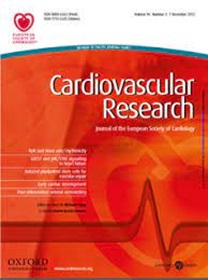Ageing-associated endothelial decorin induction and the impact of non-glycanated decorin on cardiac inflammation.
IF 13.3
1区 医学
Q1 CARDIAC & CARDIOVASCULAR SYSTEMS
引用次数: 0
Abstract
AIMS Cardiovascular disease is the leading cause of death in the European Union and aging is one of its major risk factors resulting in the progressive deterioration of the cardiac structures and function. Here, we have combined single-nucleus-RNA-sequencing, imaging, and molecular and cell biology approaches to explore the maladaptive signals that drive cardiac ageing. METHODS AND RESULTS Single-nucleus-RNA-sequencing analysis of young (3 months) and old (18 months) murine hearts revealed that the expression of decorin, a secreted proteoglycan expressed in the extracellular matrix of endothelial cells, is induced by ageing. Decorin treatment via osmotic mini-pump induced diastolic dysfunction and a pro-inflammatory environment in the myocardium characterized by increased infiltration of immune cells, increased expression of IL-1β in endothelial cells and microvascular leakage in 3 months old mice. In vitro, decorin treatment induces cardiomyocyte hypertrophy, the expression of different pro-inflammatory cytokines like IL1B in endothelial cells in a TLR2 dependent mechanism, and compromises the endothelial barrier function. CONCLUSIONS Together, our results identify non-glycanated decorin as a novel player contributing to cardiac aging and disease. This form of decorin contributes to the age-related structural and functional dysfunction of the heart by inducing a pro-inflammatory environment in the myocardial microvasculature, a hallmark of cardiac ageing.衰老相关内皮decorin诱导及非糖基化decorin对心脏炎症的影响。
在欧洲联盟,心血管疾病是导致死亡的主要原因,衰老是导致心脏结构和功能逐渐恶化的主要危险因素之一。在这里,我们结合了单核rna测序、成像、分子和细胞生物学方法来探索驱动心脏衰老的不适应信号。方法与结果对幼龄(3个月)和老年(18个月)小鼠心脏的单核rna测序分析显示,内皮细胞细胞外基质中表达的一种分泌蛋白多糖decorin的表达是由衰老诱导的。3月龄小鼠经渗透性微泵治疗的Decorin诱导舒张功能障碍和心肌促炎环境,其特征是免疫细胞浸润增加、内皮细胞IL-1β表达增加和微血管渗漏。在体外,decorin处理诱导心肌细胞肥大,内皮细胞中IL1B等不同促炎细胞因子以TLR2依赖机制表达,并损害内皮屏障功能。综上所述,我们的研究结果确定了非糖基化的decorin是一种促进心脏衰老和疾病的新参与者。这种形式的decorin通过在心肌微血管中诱导促炎环境(心脏老化的标志),有助于与年龄相关的心脏结构和功能障碍。
本文章由计算机程序翻译,如有差异,请以英文原文为准。
求助全文
约1分钟内获得全文
求助全文
来源期刊

Cardiovascular Research
医学-心血管系统
CiteScore
21.50
自引率
3.70%
发文量
547
审稿时长
1 months
期刊介绍:
Cardiovascular Research
Journal Overview:
International journal of the European Society of Cardiology
Focuses on basic and translational research in cardiology and cardiovascular biology
Aims to enhance insight into cardiovascular disease mechanisms and innovation prospects
Submission Criteria:
Welcomes papers covering molecular, sub-cellular, cellular, organ, and organism levels
Accepts clinical proof-of-concept and translational studies
Manuscripts expected to provide significant contribution to cardiovascular biology and diseases
 求助内容:
求助内容: 应助结果提醒方式:
应助结果提醒方式:


